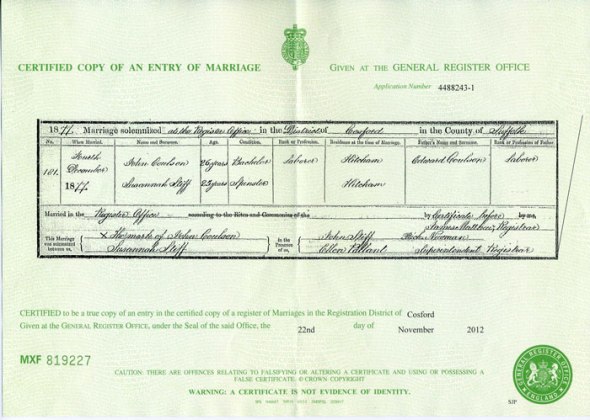Civil Marriage and Witness Identification
Posted: 03 Dec 2012 Filed under: Genealogy resources, Sue's family research | Tags: 50 Marriage Mondays, Coulson, Hadleigh, Marriage law, Stiff, Trade directory 7 CommentsThis week’s 50 Marriage Mondays post considers the civil marriage procedures followed by my great-grandparents and examines the identity of witnesses.

General Register Office. Certified Copy of an Entry of Marriage (Marriage Certificate). Register Office, Cosford, Suffolk, no. 181. John Coulson & Susannah Stiff, 1877/12/04. issued 22 November 2012. citing RD Cosford, 1877 Dec quarter, vol 4a, p. 966.
Bride: Susannah Stiff
Groom: John Coulson
Date: 4 December 1877
Location: Cosford District Register Office
Marriage Law
Civil marriage was introduced in 1837 by the Marriage Act 1836 , and modified by the Marriage and Registration Act 1856 . So, in 1877 the John and Susannah followed these procedures:
- One of the parties of the intended marriage had to give notice to the Superintendent Registrar and make a written declaration that there were no impediments to the marriage. In this case, the couple met the Kindred Affinity requirement (i.e. not too closely related), had resided within the registration district for more than 7 days preceding the notice, were over 21 so did not need any parental permission, and were both single so free to marry.
- The registrar recorded the Notice of Marriage in a Marriage Notice Book.
- The Notice of Marriage was to be publically displayed at the Superintendent Registrar’s Office for 21 days. During this time, any objections to the marriage could be lodged.
- If no objections had been raised after the 21 days, the Registrar issued a Certificate, valid for 3 months, which confirmed that notice had been given and no objections raised. Without such a certificate, license or the reading of banns no marriage could legally take place. This is the certificate referred to on the above Certified Copy of an Entry of Marriage.
- The marriage was solemnised in a registered building in the presence of a Registrar and two or more credible Witnesses in a Ceremony that included the declarations of each of the Parties, ‘I do solemnly declare, That I know not of any lawful Impediment why I A.B. may not be joined in Matrimony to C.D.‘ And, to each other, ‘I call upon these Persons here present to witness that I A.B. do take thee C.D. to be my lawful wedded Wife [or Husband.]‘. In this case, the registered building was the Register Office, rather than a church or other religious establishment.
Where was Cosford District Register Office?
The two largest towns in Cosford District, which existed between 1837 and 1930, were Hadleigh and Lavenham. Trade directories (see Historical Directories), the 19th century equivalent to the Yellow Pages, include registrars in their listings. The 1869 Post Office Directory places Superintendent Registrar Richard Newman at Hadleigh and the Kelly’s 1892 Directory places Registrar James Matthew at Hadleigh, so I am reasonably sure this marriage was solemnised at Hadleigh.
Who were the Witnesses?

Witnesses to the Marriage of John Coulson & Susannah Stiff (green). Ellen Pallant (red) and 3 possible John Stiffs (yellow)
The two witnesses are named as John Stiff and Ellen Pallant. Ellen was Susannah’s cousin. At least 3 John Stiffs could be the other witness. All were relatives of Susannah, an uncle, a cousin and a half brother. I can’t help wondering if Ellen was a bridesmaid and Uncle John gave the bride away.
© Sue Adams 2012






Witnesses to a marriage can be extremely interesting. My grandfather had a cousin, Martha Endley born in 1871 who seemed to disappear from the censuses after 1891 though there was no trace of her having died or married. The mystery was solved when I obtained the marriage certificate of my grandfather’s sister who married in 1900. One of the witnesses was Pattie Endley, Pattie being a diminutive of Martha. Martha also married (and presumably was named in the banns) as Pattie but in later life reverted to being Martha. Had I not obtained the certificate I would never have been able to find and follow her again.
LikeLike
I agree that witnesses provide important clues! It is a pity that witnesses are not included in marriage registration indexes.
LikeLike
Yes perhaps, but a minor consideration when one doesn’t even get the date of, nor the exact place of the marriage from indexes, nor for ealy marriages the surname of the other party…
LikeLike
Even better, a fully searchable transcript linked to a digital image of the original. Sadly, we would have to amend civil registration laws of England & Wales. Currently the public can only access the full information by ordering a ‘Certified Copy of and Entry of the [birth, marriage of death] register’. I can dream, can’t I?
LikeLike
We will have to dream on as recent events aren’t even indexed. All down t money I fear and to get us to buy certificates in the hope we have chosen the right one. Greatful thanks though to the happy bands of volunteer transcribers who provide indexes and transcripts.
LikeLike
[…] introduction of civil marriage by the Marriage Act 1836 brought in the procedures I discussed in ‘Civil Marriage and Witness Identification’. Non-conformists could then choose either a Church of England or civil marriage, but their own […]
LikeLike
[…] Civil Marriage and Witness Identification […]
LikeLike